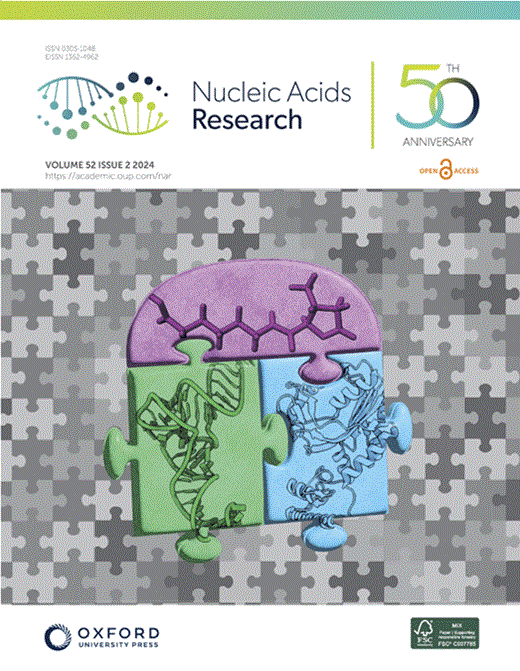由RNA替代质子化引起的移位G•U摆动对的鉴定和表征
IF 13.1
2区 生物学
Q1 BIOCHEMISTRY & MOLECULAR BIOLOGY
引用次数: 0
摘要
RNA可以作为酶、小分子传感器和疫苗,它可能是生命起源的管道。尽管有这些深刻的功能,RNA被认为具有有限的分子多样性。一个紧迫的问题是RNA是否可以采用新的分子状态来增强其功能。RNA的共价修饰已被证明可以增强生物功能,但对非共价修饰(如新型质子化或互变异构体形式)所知甚少。通常,一个G•U摆动有U位于主槽。我们使用化学信息学方法确定了移位G•U摆动的四个结构家族,其中G位于主槽中,这需要碱的可选互变异构状态或U的阴离子状态。我们通过U与二甲基硫酸盐(DMS)的非常规体内反应性为这些移位G•U摆动提供了实验支持。这些移动的摆动可能发挥功能作用,可以作为药物靶点,因为它们在细菌和叶绿体中很常见,但在真核生物和古细菌中代表性不足。我们的化学信息学方法可以应用于识别其他RNA基序以及DNA和蛋白质中的替代质子化状态。本文章由计算机程序翻译,如有差异,请以英文原文为准。
Identification and characterization of shifted G•U wobble pairs resulting from alternative protonation of RNA
RNA can serve as an enzyme, small molecule sensor, and vaccine, and it may have been a conduit for the origin of life. Despite these profound functions, RNA is thought to have limited molecular diversity. A pressing question is whether RNA can adopt novel molecular states that enhance its function. Covalent modifications of RNA have been demonstrated to augment biological function, but much less is known about non-covalent alterations such as novel protonated or tautomeric forms. Conventionally, a G•U wobble has the U located in the major groove. We used a cheminformatic approach to identify four structural families of shifted G•U wobbles in which the G instead resides in the major groove, which requires alternative tautomeric states of either base, or an anionic state of the U. We provide experimental support for these shifted G•U wobbles via the unconventional in vivo reactivity of the U with dimethylsulfate (DMS). These shifted wobbles may play functional roles and could serve as drug targets, as they are common in Bacteria and chloroplasts, but underrepresented in Eukaryotes and Archaea. Our cheminformatics approach can be applied to identify alternative protonation states in other RNA motifs, as well as in DNA and proteins.
求助全文
通过发布文献求助,成功后即可免费获取论文全文。
去求助
来源期刊

Nucleic Acids Research
生物-生化与分子生物学
CiteScore
27.10
自引率
4.70%
发文量
1057
审稿时长
2 months
期刊介绍:
Nucleic Acids Research (NAR) is a scientific journal that publishes research on various aspects of nucleic acids and proteins involved in nucleic acid metabolism and interactions. It covers areas such as chemistry and synthetic biology, computational biology, gene regulation, chromatin and epigenetics, genome integrity, repair and replication, genomics, molecular biology, nucleic acid enzymes, RNA, and structural biology. The journal also includes a Survey and Summary section for brief reviews. Additionally, each year, the first issue is dedicated to biological databases, and an issue in July focuses on web-based software resources for the biological community. Nucleic Acids Research is indexed by several services including Abstracts on Hygiene and Communicable Diseases, Animal Breeding Abstracts, Agricultural Engineering Abstracts, Agbiotech News and Information, BIOSIS Previews, CAB Abstracts, and EMBASE.
 求助内容:
求助内容: 应助结果提醒方式:
应助结果提醒方式:


